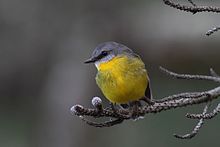Gold-bellied flycatcher
| Gold-bellied flycatcher | ||||||||||||
|---|---|---|---|---|---|---|---|---|---|---|---|---|

Gold-bellied flycatcher ( Eopsaltria australis ) |
||||||||||||
| Systematics | ||||||||||||
|
||||||||||||
| Scientific name | ||||||||||||
| Eopsaltria australis | ||||||||||||
| ( Shaw , 1790) |
The Eastern Yellow Robin ( Eopsaltria australis ) is a species of bird from the family of the catch (Petroicidae). The species is endemic to eastern Australia .
The IUCN specifies that the gold-bellied flycatcher is not at risk ( least concern ). Several subspecies are distinguished.
description
The gold-bellied flycatcher reaches a body length of 13.5 to 17 centimeters, a wingspan of 22.5 centimeters and a weight of 18 to 20 grams. The female usually stays smaller than the male. There is otherwise no significant dimorphism between the two sexes .
The plumage is grayish in color in the area of the head, the wings, the tail and the back. The chest and belly are yellowish while the throat is light gray in color. The populations in the northern regions are more clearly colored yellow than the populations from southern regions. The small and powerful beak and legs are black.
Possible confusion
It can be confused with the gray- mantled flycatcher ( Eopsaltria griseogularis ) and the pale-faced flycatcher . In both species, however, the breast is more clearly colored gray, so that it can only be confused in bad light.
The pale-faced flycatcher is slightly smaller than the gold-bellied flycatcher and more delicate in build. The two species can also be distinguished by their behavior: the golden-bellied flycatcher is restless, keeps raising its tail plumage and twitching its wings, which the pale-faced flycatcher usually does not do.
Habitat and Distribution
The gold-bellied flycatcher is endemic to eastern and south-eastern Australia . Its main distribution includes the coasts and adjacent hill country of southeastern Queensland , eastern New South Wales, and Victoria . Its preferred habitats are the open forests and in the north also the edges of tropical rainforests and mountain regions up to around 1,000 meters above sea level . Higgins et al. point out that the gold-bellied flycatcher is a comparatively adaptable bird species that colonizes a number of habitats as long as they have high undergrowth and sparse ground cover. It is most commonly found in the thick undergrowth of eucalyptus forests. But it also occurs in subtropical and tropical rainforests and acacia thickets. He also populated plantations with the pines imported into Australia.
Despite its adaptability, the gold-bellied flycatcher is sensitive to fragmentation or disturbance of its habitats. For example, it does not occur in sparse forests when cattle graze there. It is also absent in gardens and only occurs in parks where larger areas remain undisturbed.
Way of life
The gold-bellied flycatcher is an insect hunter that hunts its prey both on the ground and in trees. During the spring and summer, i.e. during the breeding season, the gold-bellied flycatcher forms a pair bond. In winter it forms small, loose groups that go looking for food together. It is then more often associated with other insect-eating songbirds. Most of these are birds of the genus Acanthiza . It is a curious bird that often shows little shyness towards humans. He occasionally follows people who work in the garden to catch the insects they scare off.
food
The gold-bellied flycatcher feeds mainly on insects ( Insecta ), small arachnids ( Arachnida ) and other small arthropods ( Arthropoda ). It is an excellent insect hunter who ambushes its prey on a low branch and then catches it in short flights. But it also searches the ground and leaves for prey.
Reproduction
The mating season extends from July to January. During this time there can be up to three annual broods. The bowl-shaped nest is built by the female in forks of branches of trees or larger bushes. The nest is usually built from grass and root fibers that are glued together with cobwebs. The clutch consists of two to three eggs, which are incubated by the female for about 12 to 13 days. During this time, the female is provided with food by the male. The nestling period is about 14 days. The life expectancy of the goldcatcher in the wild is around four years.
Subspecies
- Eopsaltria australis austina Mathews , 1914
- Eopsaltria australis australis ( Shaw , 1790)
- Eopsaltria australis coomooboolaroo Campbell , 1913
- Eopsaltria australis chrysorrhos Gould , 1869
Danger
In the IUCN Red List , the gold-bellied flycatcher is listed as "not at risk" ("least concern").
literature
- Bernhard Grzimek: Grzimeks animal life. Volume 7-9 birds . Deutscher Taschenbuch Verlag GmbH & Co. KG, Munich 1993.
- PJ Higgins (Ed.): Handbook of Australian, New Zealand & Antarctic Birds , Volume 2, Raptors to Lapwings, Oxford University Press, Oxford 1993, ISBN 0-19-553069-1 .
- Gottfried Mauersberger, Wilhelm Meise: Urania Tierreich, 7 vols., Birds . Urania, Stuttgart 1995. ISBN 3-332-00500-6 .
Web links
- Eopsaltria australis in the endangered Red List species the IUCN 2011. Posted by: BirdLife International, 2009. Accessed November 13, 2011th
Single receipts
- ↑ Handbook of the Birds of the World on the Pale Face Snapper accessed on June 8, 2017.
- ↑ a b Higgins (Ed.): Handbook of Australian, New Zealand & Antarctic Birds . Volume 2, p. 770.
- ↑ Higgins (Ed.): Handbook of Australian, New Zealand & Antarctic Birds . Volume 2, p. 764.
- ↑ a b c Higgins (Ed.): Handbook of Australian, New Zealand & Antarctic Birds . Volume 2, p. 771.
- ↑ Higgins (Ed.): Handbook of Australian, New Zealand & Antarctic Birds . Volume 2, p. 774.



